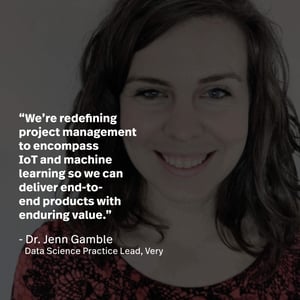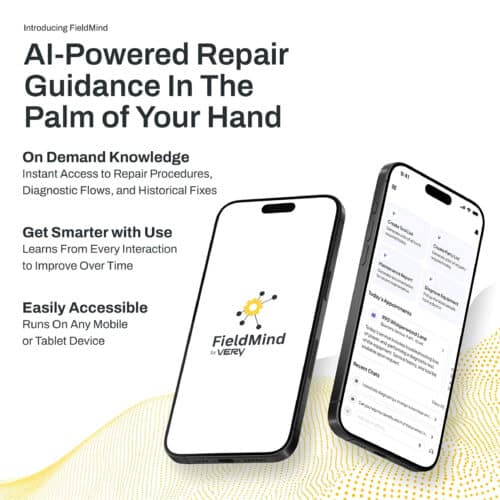BLOG
Buzzword Bingo: IoT, AI, ML, & Agile in the Real World
The tech industry loves buzzwords. Words like IoT, AI, machine learning (ML), and agile flit through the headlines of industry publications nearly every week. But what do they actually mean, and how will they make an impact on your business?
During Connected Things 2020: WFH Edition hosted by Very and MIT Enterprise Forum Cambridge, I was happy to speak about the topic as the Data Science Practice Lead for Very. Watch the video above to see the whole talk, and check out the highlights that I’ve outlined below.
The Thing About Buzzwords
One of the tricks with buzzwords is that each one generally has a core element that’s actually meaningful, but then it becomes used in so many different contexts that the original meaning gets lost. If you hear someone spouting off a bunch of buzzwords, it’s important to try and dig in to understand specifically what they mean.
Machine learning and AI, for example, are terms often used interchangeably, and what they mean can vary depending on who you’re talking to. For some people, if you’re using data to train a model, making predictions based on that model, and doing that iteratively, they’d call it machine learning – even if the model itself isn’t a deep learning neural network.
On the other hand, some purists argue that statistics-based modeling approaches don’t qualify as machine learning. They’d say that only modeling approaches like ensemble tree-based methods, deep learning methods, reinforcement learning, etc. qualify as machine learning.
IoT, too, can mean different things to different people. It can be difficult to differentiate between smart vs connected products, for example. Additionally, with so many potential applications of IoT, from the smart home to the smart city to the smart factory, the term can feel overly broad.
Finally, the agile methodology, while used primarily for software development, has expanded to other disciplines as well. Every company seems to have its own version of the agile approach, and the word itself is commonplace marketing terminology in a world where everyone is trying to do more with less.
In this discussion, we will:
- Allow the term Machine Learning to include any system which makes predictions, recommendations, or decisions based on models learned from data (as opposed to rule-based approaches), and allow it to include statistical modeling, deep learning, or other modeling/learning techniques.
- Define an IoT product as hardware that has been enhanced with Internet connectivity.
- Explore the intersection between IoT and ML, and how we use our own agile process at Very to build products that encompass both.
Exploring a New Kind of Product Management with ML & IoT
The goal of machine learning initiatives in most enterprises is usually to get insights – there’s another buzzword for you – that can help you define actions and workflows that lead to better business decisions.
When you’re trying to gather insights from IoT data, there’s a lot more complexity than you’d encounter in traditional software. Edge data can vary in type and completeness, requiring additional processing to glean valuable insights (which is why IoT data scientists are relevant and necessary).
Additionally, there are a lot of product management questions that come into play while you’re building a solution. For traditional software, when you’re doing product management, you’re trying to make sure that technical requirements and end-user requirements are all coming together within a user-centered design. All of those disciplines have been developed over the past 10-20 years, so the processes are very robust and fleshed out.
Now, we’re looking at extending those ideas to encompass machine learning development and IoT development. We’re asking, what’s the new version of product management that includes all of these things?
At Very, on each machine learning project, we have to address:
- What data is available?
- What are the types of statements that we want to be able to make in the application? Is it predictions, recommendations, automated decision-making?
- Who are the end-users?
- What are the workflows that we’re hoping to enable based on this data?
- What’s possible from a predictive modeling or machine learning recommendation perspective?
Then, as we build out the end-to-end application, we apply an agile development approach to all aspects of the system, including the data science development work for the data pipelines and machine learning models.
Bringing Agile Development to Machine Learning and IoT
One of the reasons I joined Very was because I am interested specifically in agile development practices for machine learning applications. Very is one of the leaders, in my opinion, in agile development practices for building IoT products, and those very often require machine learning components for certain types of predictions or recommendations (for example, a facial recognition-powered beer kiosk system). In general, in the industry, agile development practices and data science don’t always go hand in hand, so what Very’s doing in that regard is pretty cutting edge.
One of the things that makes agile IoT development so successful at Very is our capacity for multidisciplinary work. As a fully remote company long before the COVID-19 pandemic, we’ve become experts in remote collaboration and asynchronous communication. We regularly practice remote pair programming between engineers working on different aspects of a project, like data science and hardware.

This helps each person to understand how the piece they’re working on fits into the whole so that we can create and improve upon development processes. It can be tricky to follow the agile development practice of building “thin, vertical slices”, when those slices cut through not just the UI and backend, but also hardware, firmware, and machine learning elements of the stack. A cohesive team that remains in tight communication, where all members understand the entire system at a high level (not just their own component), can be essential here.
With machine learning specifically, we’re often in a situation where we want to start prototyping the system even before “real” data is flowing. In this case, it’s often useful to use simulated data, and a good rule of thumb is to do the data simulation as close to the data source as possible.
For example, say we want to build an anomaly detection model for an industrial IoT application that streams data off of a PLC on a production line.
One option would be for a data scientist to work in isolation building an anomaly detection pipeline off of data that they simulate in Python.
Another option (which brings us much closer to a product that will work in production) is to have the data scientist working together with a firmware developer and backend engineer, setting up the pipeline which runs all the way from data getting simulated on the firmware of a test PLC in the lab, transmitted over cellular, and processed in the cloud (although the anomaly detection piece might be the same in both cases).
Then when it’s time to hook the PLC up to the real plant with the same firmware and basic system, you’re that much closer to a fully-functioning solution.
Obviously, simulated data won’t be useful for training accurate models and making predictions, but it can give you a big head start on the scaffolding of the system, and is also extremely valuable for unit and integration testing. Ultimately, this can shorten your time to market for the final product, especially when compared to a process where components are developed in isolation, and then “assembled” towards the end of development.
Conclusion
At the end of our talk during Connected Things 2020: WFH Edition, our moderator and MITEF board member Mark Thirman asked if I had any closing advice for our attendees.
I shared with him that it’s a really exciting time in the IoT and machine learning spaces, and not to worry too much if you’re feeling like you’re behind the innovation curve. It’s never too late to get started, especially when you partner with a company like Very who’s been there, done that.









